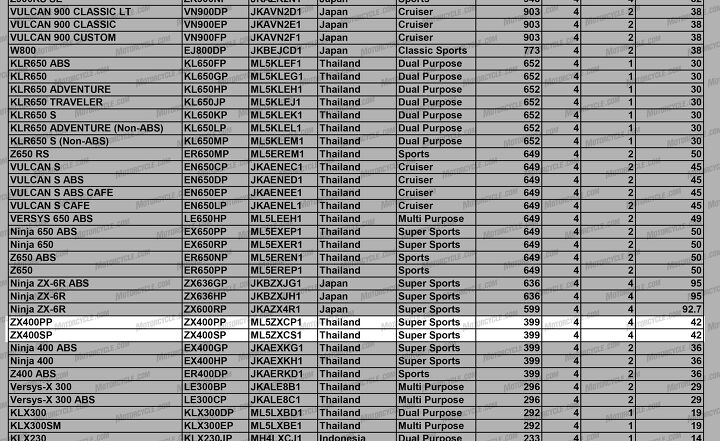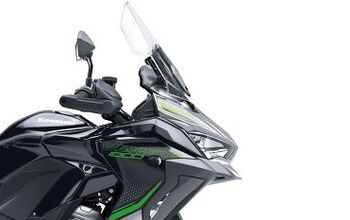How Much Power Does The 2023 Kawasaki Ninja ZX-4RR Make?

US-spec models may be significantly down on power
We’ve been covering the Kawasaki Ninja ZX-4R for a while now, and even up until it was revealed this week, there was skepticism about whether the little four-banger would actually come to America.
Join the Kawasaki Ninja ZX-4R Forum
After the official announcement, the obvious questions came up: How much does it cost? How much does it weigh? And how much horsepower does it produce? Kawasaki answered the first two, with the 2023 Ninja ZX-4RR priced at $9,699 with a claimed curb weight of 414.5 pounds. Kawasaki USA was less forthcoming about the power output, only describing “a very linear power delivery that provides great street-going performance at lower engine speeds while excelling as the revs climb to its over-15,000 rpm redline.”
It’s not unusual for the American subsidiaries of motorcycle manufacturers to omit performance figures, but fortunately, their International counterparts tend to be more forthcoming. Kawasaki Europe’s announcement, revealed the Ninja ZX-4RR (plus the ZX-4R variant that isn’t being offered in the U.S.) will make 57 kW (76.4 hp) from the 399cc 16-valve Inline-Four, and 59 kW (79.1 hp) with ram air. Those figures do come with some asterisks, however, as the European press release notes specifications may be subject to change and may vary from market to market.
Meanwhile, Australian certification data has the ZX-4 models producing 55 kW (73.8 hp), and unlike Kawasaki Europe, it also cites the engine speed that produces that peak: 14,500 rpm.
So, in international markets, you can expect to get something in the mid-to-high 70s for horsepower from the ZX-4R. But if you’re in the U.S., you may need to temper your expectations.
Motorcycle.com has obtained vehicle identification number information submitted by Kawasaki to the National Highway Traffic Safety Administration has the ZX-4RR (listed under its model code of ZX400SP) as producing just 42 kW, or 56.3 hp. Whether that’s with or without ram air matters little, as prospective American customers may be disappointed to know the ZX-4RR is down more than 25% from the European spec. Or, to put it another way, the ZX-4RR claims less power than the Vulcan S.
Sure, the Vulcan’s got 250cc over the ZX-4RR, but customers expect more from a four-cylinder Ninja, especially one with a double-R designation. So, what gives?
The most likely culprit is a lower rev limit. Kawasaki Canada notes on its official website that the ZX-4R and ZX-4RR “have a maximum RPM of 11,500 rpm in Canada due to noise regulations.” Those regulations state a maximum volume between 78 dBA and 83 dBA, depending on the testing methodology.
Regulations in America vary by the state, but many fall somewhere within that range for motorcycles travelling at speeds faster than 35 mph. This leads us to believe that the U.S.-spec Ninja ZX-4RR also has a maximum engine speed limited well below the 16,000 rpm indicated on the issued press photos (which note they are for European spec models), but also below the “over-15,000 rpm redline” Kawasaki USA claims in its materials.
We reached out to Kawasaki USA about the Ninja’s rev limit and were told they were awaiting final confirmation on specs from Japan. So, like their European counterparts say, specifications may still be subject to change. We’ll provide an update when Kawasaki USA has more to tell us.
An actual limit within the 11,000 to 12,000 rpm range is about 75% of the “over-15,000 rpm” claimed redline, which may be enough to choke the U.S.-spec Ninja ZX-4RR down to a 56.3 hp output from the European figures.
As Troy noted with Kawasaki’s announcement, the ZX-4RR KRT is only $1,000 less than the ZX-6R, making it hard for some customers to lean towards the smaller bike. If there is a rev limit on the ZX-4RR, that would neuter one of its major appeals, the sound of four small pistons pounding at an extremely high engine speed.
Of course, ECU tuners may be able to unlock more power from the ZX-4RR, helping it reach more of its potential. But that means spending a little bit more money on top of the ZX-4RR’s $9,699 MSRP.
Become a Motorcycle.com insider. Get the latest motorcycle news first by subscribing to our newsletter here.

Dennis has been a part of the Motorcycle.com team since 2008, and through his tenure, has developed a firm grasp of industry trends, and a solid sense of what's to come. A bloodhound when it comes to tracking information on new motorcycles, if there's a new model on the horizon, you'll probably hear about it from him first.
More by Dennis Chung






































Comments
Join the conversation
What is the appeal of a small displacement motorcycle?
Revving it out.
Lighter.
Cheaper.
This bike, if it comes as stated in the article, is a failure on all counts. I surely hope they figure out how to make full power in the U.S. market. As it stands I see many potential buyers going for a ZX-6R, STR or Duke 790, all available at nearly the same price and weight but with double the power.
Figure it out Kawasaki!
In the land of the liter bike availability as a starter motorcycle, why would kawasaki neuter such a seemingly awesome machine? Just do what I did, get a 2 yo Zx-6r, I got a non abs 30th anniversary under 4500 miles for $6800 out the door. Put it in low, take it to the track, have the suspension set up, and enjoy. I rode mine twice at COTA, bucket list item marked off. I guess at maybe 6 more pounds for my 6r, I'll keep it for a while still